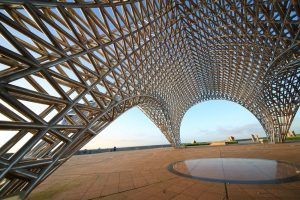>> Last Updated on
What is an Organic Model
 In the 3D computer graphics world, an organic model doesn't mean that it is certified without chemicals. Organic modeling refers to the shape of the 3D model being created. In fact, organic modeling is generally considered to be the opposite of hard surface modeling, even though the distinction isn't as clear in practice (read more about it here).
In the 3D computer graphics world, an organic model doesn't mean that it is certified without chemicals. Organic modeling refers to the shape of the 3D model being created. In fact, organic modeling is generally considered to be the opposite of hard surface modeling, even though the distinction isn't as clear in practice (read more about it here).
An organic model is defined as a 3D model that represents a living creature. The keyword here is that it only needs to 'represent' something living. Indeed, a statue of a human or an animal would still count as an organic model. And of course, all plants, trees, insects, animals, humans and alien creatures would all be organic too.
However, this definition isn't wide enough to include everything that is indeed organic modeling. In fact, organic patterns exist a little bit everywhere in nature, in living beings or not. For example, any model with creases and folds will generally be created by organic modelers. These could be lava fields, dead trees, sculpted surfaces, architectural ornaments, etc.
 Specialization in Organic Modeling
Specialization in Organic Modeling
Oftentimes, 3D modelers will specialize exclusively in either organic or hard surface modeling, because they require slightly different skills and interests. It is possible, but rarer, to find a 3D modeler that is equally specialized and experienced in both types of modeling. In actuality, this distinction of modeling categories exists mostly because of a need for the film, TV and gaming industry to describe different work positions efficiently. It quickly defines what is expected of the artist's skills and what type of objects he/she will be assigned to create.
Organic modeling is a specialization of 3D modeling, generally considered more advanced because of the level of difficulty and skills required. This doesn't mean that it is the final goal of every junior 3D modeler, nor is it only for the end of a career. In fact, not everyone will become or want to be an organic modeler, it simply depends on your interests. You should be able to find out in time, which one feels right to you, by starting with simpler objects, that may have a mix of hard and vaguely organic surfaces, such as a lamp. Other alternatives such as hard surface modeling and architectural 3D modeling, can be just as difficult and still very challenging, in different ways.
If there is one big advantage of working in a smaller studio is that there is usually more variety in the tasks being assigne. In a bigger studio, tasks tend to be highly subdivided and very specialized so everyone does one thing in the chain. On the other hand, small enterprises love versatile artists because they can fill in the gaps when needed. Therefore, if you land a generalist 3D modeling position, you may be asked to model all kinds of 3D objects, both organic and hard surface. The main characters may still, however, be outsourced to a specialized 3D character modeler, because of the complexity.
Animating Organic Surfaces
A key factor in determining what is an organic surface model is how it will be animated. If the model will deform, need a skeleton, or muscle bulging while moving, then it is definitely an organic model. If the model rather bends or shift using mechanical parts, it is a hard surface. Armored characters, insects and shelled marine animals could be considered both, but if they are meant as a character instead of a static background item, then it will be given to an organic modeler to prepare for rigging. An rigged character model will need to be specially prepared for deformation.
Key Skills for Organic Modelers
3D organic modeling requires the usual skills of all 3D modelers, but also a few more specialized skills, borrowed from the science of biology and the art of sculpture. This applies to organic modelers, character modelers and digital sculptors.
Understanding of Anatomy & Biology
 A very important skill for 3D organic and character modelers is knowledge of how living beings are constructed. A 3D organic modeler has to be able to understand the principles of biology and have a good knowledge of anatomy. In fact, it is absolutely essential in every situation for a character modeler. This is especially true in visual effects, where you need to be able to model accurate and realistic characters to replace filmed characters in a film or TV series.
A very important skill for 3D organic and character modelers is knowledge of how living beings are constructed. A 3D organic modeler has to be able to understand the principles of biology and have a good knowledge of anatomy. In fact, it is absolutely essential in every situation for a character modeler. This is especially true in visual effects, where you need to be able to model accurate and realistic characters to replace filmed characters in a film or TV series.
And this understanding of biology even extends to every imaginary alien species every made. This is because of another human trait: anthropomorphism. It's our tendency to recreate what we know and to project how we are into it. Have you ever noticed how aliens on the big screen often have very 'human-like' traits. This is no coincidence if they are symmetrical or if they have two arms, two legs, two ears, a head, a mouth, a nose, and maybe extra appendages similar to lobsters. Because our collective psyches only have had examples of earth-like creatures so far, it makes sense that we replicate what is in our imagination in our artistic products. It is a little bit as though we are projecting our own possible evolutionary outcomes, into our imaginary creations on the big screen.
But also, nature has a way of organizing the structure of living creatures in similar ways. This might be because we are all carbon-based lifeforms with a common ancestor linking every living organism on earth. Another alternative might be that this is the only evolutionary outcome that possible to make a functional organism. The underlying the structure of living creatures may actually create the shapes of life we see today because it is simply the most efficient way of doing things that work well. For example, muscles are working in similar ways and act on skeletons connected in similar ways as well. It may be the need for motion that actually drives the shape of living creatures throughout evolution
Watch out for the 'Uncanny Valley' !
As a character artist, it's easy to fall into this trap. Read our article on the uncanny valley to understand why.
 A Great Attention to Detail
A Great Attention to Detail
First of all, for all artists, the attention to detail is important. But in organic and character modeling, the level of detail and the attention to accuracy and realism has to be one step further. The attention to detail we expect in a character, human or imaginary, is enormous. From the general accuracy of the shape, to the little details of the body part junction, to the bulges of the muscles, there is a lot to take into account. In addition to that, there are the skin details, the folds of skin abd the texture of the skin itself. Finally there are the imperfections and wear & tear, which is essential to the 'personnality' of the model. It makes the model actually come alive, have a history and a way of doing things influenced by his 'rugged' or not appearance.
Solid Topology Skills
Topology is the skill of efficiently placing and connecting edges and edge-loops in 3D modeling. It is essential to be able to manage the number of subdivisions of a 3D model, but also where those subdivisions are placed, for the purpose of animation. It is also important to know how and when to connect those edges properly and cleanly without breaking the edge-flow. Doing so for an entire character is a great challenge that require experience in 3D modeling.
Also, depending on the purpose of the 3D model you will have different constraints on edge-efficiency and correct topology. While the film industry is not as strict on the polygon count, it requires a much heavier level of detail. It is also modeled using 'quads' or polygons with four sides. On the other hand the gaming industry will require you to optimize every model as much as possible every triangle, that are used to make the model.
Extra Challenges of Characters
Organic character modeling also very often comes extra challenges to make a convincing and detailed character. For example, there is almost always clothing and hair, sometimes Fur, Wings or Feathers or maybe folds of skin and complex articulations.
Tutorial on Organic Modeling
Recommended Books
Related Articles
More information on organic modeling
Back to the careers Table of Contents
 Careers in the 3D Animation & Visual FX Industry
Careers in the 3D Animation & Visual FX Industry
Featured Sections
- The different 3D Modeling Specializations for the next Digital Age
- Check out our complete Guide on 3D Computer Hardware
- Or just vote for your favorite 3D software
Artist Hubs:
www.artstation.com, www.cgsociety.com, www.awn.com, www.highend3d.com
Tell us what you think, we welcome your comments! Did we miss something?
Join the Wombats
Opt-in our occasionnal newsletter to be the first to be informed of our new tutorials series, original content updates, special offers and important announcements! It’s free and spam-free, plus you can unsubscribe at any time.
Follow @3Dwombat on Social Media






